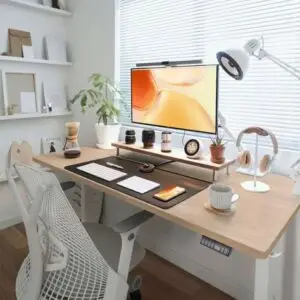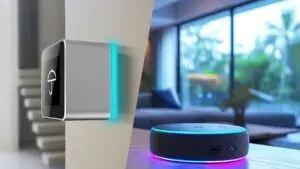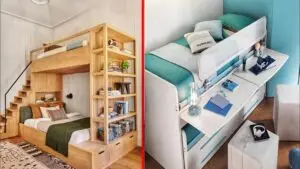A well-designed home office setup can make or break your productivity. When you work from home, your environment shapes your focus, comfort, and creativity. Many people make the mistake of using poor furniture, ignoring ergonomics, or letting clutter build up, which kills motivation fast. A smart home office setup helps you stay efficient while keeping your body healthy and your mind clear. In this guide, you’ll learn everything about creating a functional workspace—from budget-friendly fixes to professional-grade upgrades—so you can enjoy a workspace that inspires and supports you every day.
1. Define Your Needs Before You Buy
Before buying anything for your home office setup, take time to define what you truly need. Your workspace should reflect your daily work style. If you’re a writer, you’ll need a calm corner with fewer distractions. Designers or developers may need multiple monitors and more desk depth. Think about how long you sit at your desk each day and whether you’ll expand your setup later.
You also need to assess your available space. A spare room offers freedom for a full workstation, but a small apartment might call for a compact, multi-purpose desk. Plan for the future too—remote work is growing fast, and flexible setups are now essential.
2. Choosing the Right Desk
Your desk is the centerpiece of your home office setup. The size depends on your tasks. A 48-inch-wide surface fits a monitor, keyboard, and notebook easily. If you multitask, a larger L-shaped or corner desk provides more breathing room.
Height matters too. Fixed desks are budget-friendly, but adjustable standing desks help prevent stiffness and boost circulation. When possible, choose durable materials like solid wood or steel frames. Built-in cable ports and trays keep your workspace tidy.
Table 1: Common Desk Types for Home Offices
| Desk Type | Best For | Average Cost | Space Needed |
| Straight Desk | Small spaces, writing tasks | $100–$250 | Low |
| L-Shaped Desk | Multitasking, dual screens | $200–$500 | Medium |
| Standing Desk | Health-conscious workers | $300–$700 | Medium |
| Corner Desk | Compact setups | $150–$400 | Low |
3. Ergonomic Seating & Posture
A good chair supports your back and keeps your posture natural. Poor seating leads to back pain, fatigue, and even long-term injuries. Look for chairs with adjustable height, lumbar support, and breathable mesh material. Armrests should allow your shoulders to stay relaxed.
Set your monitor at eye level and your feet flat on the floor. If your chair is high, use a footrest for support. Short five-minute breaks every hour help refresh your body. Even a few stretches or a short walk improves focus and prevents stiffness.
4. Display & Monitor Setup
The right monitor setup makes your home office setup far more efficient. Dual monitors increase productivity by up to 40%. However, if your work involves reading or writing, one high-quality 27-inch display may be enough.
Keep your monitor 20 inches from your eyes and at eye level. Use adjustable arms or risers to reduce neck strain. Calibrate brightness and use blue-light filters to protect your eyes during long hours of work. If you use multiple devices, invest in a docking station for smooth switching.
5. Keyboard, Mouse & Input Devices
Your hands do most of the work, so comfort matters. Mechanical keyboards offer tactile feedback, while membrane types are quieter. Choose based on your preference and typing style.
Ergonomic keyboards and vertical mice reduce wrist strain. Keep your wrists straight and supported by soft pads. Programmable buttons on your mouse can save time when editing or coding. Clean these devices often to prevent buildup and ensure smoother movement.
6. Lighting & Ambience
Lighting is often ignored, yet it directly impacts focus and mood. Natural daylight keeps you alert, but glare on screens can strain your eyes. Position your desk near a window, but at an angle to avoid reflections.
Use task lighting like adjustable desk lamps for focused work. Warm ambient lights make evenings comfortable. You can also add soft LED backlighting behind your monitor to reduce contrast.
Table 2: Ideal Lighting Setup for Home Office
| Lighting Type | Best Use | Recommended Brightness | Notes |
| Natural Light | General illumination | N/A | Avoid screen glare |
| Desk Lamp | Task lighting | 400–800 lumens | Adjustable neck |
| Ambient Light | Relaxed mood | 100–300 lumens | Soft warm tones |
7. Power & Cable Management
A clutter of wires can ruin even the best home office setup. Plan your power access wisely. Use surge protectors and smart strips to safeguard your electronics. Label cables and bundle them neatly using clips or sleeves.
Wireless accessories help reduce cable mess but may need frequent charging. Keep a small charging dock for your phone and smartwatch near your desk. Organizing cables improves both safety and aesthetics.
8. Technology & Connectivity
Your tech setup is the brain of your home office setup. Place your router close to your workspace for stronger WiFi. For stable connections, Ethernet is better than wireless. Modern WiFi 6 routers provide great coverage and speed.
For data security, back up files using both cloud storage and external drives. A good webcam, noise-canceling mic, and ring light make video calls look professional. To prevent sudden power loss, use a UPS to protect your gear and data.
9. Organization & Storage
Clutter drains energy fast. A clean, well-organized home office setup promotes mental clarity. Store important files vertically to save space. Use drawers or floating shelves for supplies. Keep only essential tools within arm’s reach.
If you handle paperwork, use labeled folders or digital scanners for easy archiving. Every week, take ten minutes to clear unused items. This small habit keeps your workspace productive and inviting.
10. Aesthetics, Comfort & Personal Touch
A workspace that reflects your style feels inspiring. Pick a color palette that relaxes you—neutral tones with soft greens or blues work well. Add a plant or framed artwork to personalize your home office setup.
Sound and air also affect comfort. Use curtains or rugs to reduce echo. Keep your area well-ventilated, and maintain a comfortable temperature. Small elements like pleasant scents or background music can lift your mood.
11. Budgeting & Phased Upgrades
You don’t need to buy everything at once. Start with essentials and upgrade gradually. For instance, begin with a reliable desk and ergonomic chair, then add accessories over time.
Track your spending to avoid overshooting your budget. Remember, quality investments pay off long term. Reusing furniture or buying pre-owned items can cut costs without sacrificing quality.
Table 3: Home Office Budget Guide
| Category | Budget Range | Upgrade Priority | Notes |
| Desk | $150–$400 | High | Choose durable build |
| Chair | $200–$600 | High | Ergonomic is key |
| Lighting | $50–$150 | Medium | Good for focus |
| Accessories | $30–$100 | Low | Optional add-ons |
12. Maintenance & Adaptation Over Time
Your home office setup should evolve as your work changes. Check your posture, desk alignment, and chair condition every few months. Replace worn items before they cause discomfort.
Seasons affect lighting and temperature, so adjust accordingly. Keep software and device firmware up to date. Over time, small upgrades can transform your workspace into a professional studio that fits your growing needs.
Conclusion
A perfect home office setup is more than furniture—it’s about balance. When you combine comfort, function, and good design, your productivity naturally improves. Start small by upgrading your desk and chair, then fine-tune lighting and storage. Within a few weeks, you’ll notice better focus, posture, and energy. The right setup doesn’t just make work easier; it helps you enjoy your time at home while achieving professional results.
Frequently Asked Questions
1. How can I create a home office setup in a small space?
Use foldable desks, wall-mounted shelves, and compact chairs to save space. Keep only essential items on your desk.
2. What’s the best chair for long work hours?
An ergonomic chair with lumbar support and adjustable armrests provides comfort for extended sitting periods.
3. Should I get a standing desk for my home office setup?
Standing desks reduce back pain and promote better circulation, making them ideal for those who sit for long hours.
4. How do I reduce clutter in my home office?
Use drawer organizers, label cables, and schedule weekly decluttering sessions to keep your workspace clean.
5. What’s the best lighting for productivity?
A mix of natural daylight and warm task lighting creates the most comfortable and focused work environment.






One thought on “How to Build a Productive, Comfortable Home Office Setup in 2025”